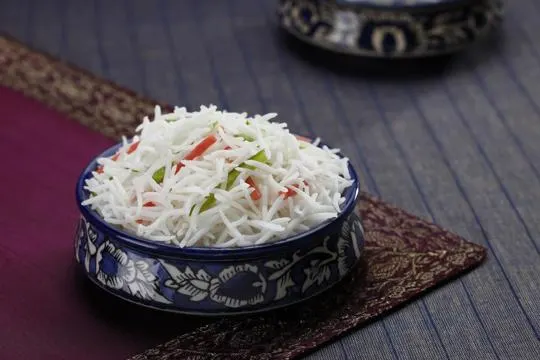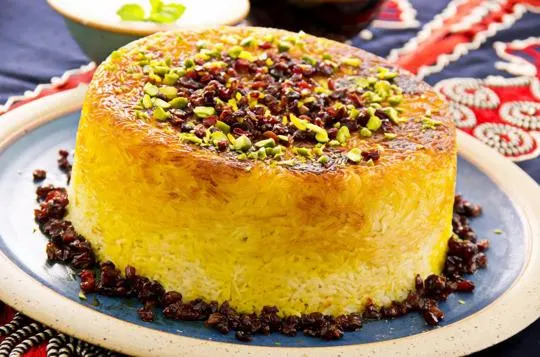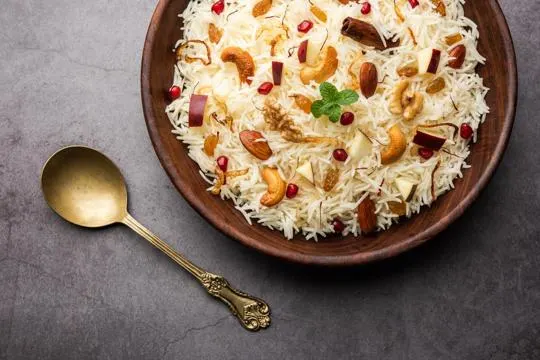Summary of key points
Persian Rice vs Basmati Rice comparison points out that while both are long-grain varieties, Persian Rice (often referring to specific preparations like Tahdig) focuses on cooking techniques that produce a crispy bottom layer. Basmati rice is aromatic and used widely in Indian and Pakistani cuisine, known for its fluffy and separate grains post-cooking. The main difference lies in the culinary applications and preparation methods.
Ever stood in the grocery aisle with a bag of rice in each hand, utterly baffled? Persian rice or Basmati rice?
It’s like choosing between two favorite TV shows. You love them both; yet, they bring different flavors to the table.
We’ve all been there, making the great rice decision. I remember the first time I tried cooking Persian rice at a friend’s dinner party. Epic fail. It turned out as mushy as a rainy day.
On the flip side, my Basmati rice skills? Chef’s kiss. It’s all about getting that perfect fluff.
Each rice has its own persona. Persian, slightly mysterious with its buttery aroma; Basmati, the long-grain star, always ready to make your curry stand out.
Deciding isn’t just about taste. It’s a culinary conundrum that digs deep into cultures, textures, and memories around our dining tables.
What is Persian Rice?

Persian Rice, or Chelo, is a popular part of Iranian cuisine.
It’s known for its texture, flavor and delicate aroma.
To make perfect Persian Rice, you need precision and technique.
One special thing about Persian Rice is the “Tahdig” — a golden crust that forms at the bottom of the pot.
This crunchy layer adds to the dish, making it delicious.
Creating the perfect Tahdig takes skill and patience.
Unlike other rice, Persian Rice is pre-boiled.
This helps the grains stay separate and fluffy – not sticking together.
The grains are long and slender, giving Persian Rice a graceful look.
Plus, the saffron gives Persian Rice a vibrant yellow color and a delicate scent.
This wonderful aroma makes the meal even better.
Traditionally, Persian Rice is served with different dishes like kebabs or stews.
Its adaptability makes it a favorite among Iranians.
What is Basmati Rice?

Basmati rice is renowned for its exceptional fragrance and flavor.
This fragrant grain comes from India’s subcontinent and is now appreciated all around the world.
It has a slender shape, fine texture, and remains fluffy after cooking.
Its scent is like that of pandan leaves or popcorn.
When cooked properly, the grains are separate and won’t stick together.
That’s why Basmati rice is considered top-notch in terms of quality and taste.
Basmati rice is great at absorbing flavors, making it the perfect companion to curries, stir-fries, and dishes with rich sauces.
This versatile grain can add extra flavor and aroma to recipes.
Plus, Basmati rice has a lower glycemic index than other types of rice.
This means it releases energy slowly, helping to keep blood sugar levels steady.
Basmati rice has been grown in the fertile lands near the Himalayan foothills for centuries.
The special climate and soil in this area are responsible for the unique taste and smell of the rice.
Additionally, authentic Basmati rice goes through a thorough aging process which boosts its flavor even more.
Differences Between Persian Rice and Basmati Rice

Persian Rice and Basmati Rice may look the same.
But, they are very different.
1 – Origin and History
The origin and history of Persian rice and Basmati rice are important in understanding the culinary traditions of these two regions.
They both have distinct features setting them apart.
Persian rice, also known as Iranian rice, is centuries old.
It is a major part of Persian cuisine and has been grown in Iran for generations.
Its special taste and texture is from the special growing techniques.
Basmati rice came from the Indian subcontinent and is very sought-after.
It has long grains and a mild aroma that adds a special touch to any dish.
Both Persian rice and Basmati rice share a long-grain structure, but they differ in flavor and cooking methods.
Persian rice is usually cooked using “kateh” which involves soaking and then sautéing before simmering.
This gives it a sticky texture.
Basmati rice needs a different approach known as “pilaf”.
This includes washing the grains to remove starch before cooking with spices, vegetables, or meat.
The result is light, separate grains.
Basmati rice is popular all over the world for its variety and suitability to different cuisines.
Its aroma adds an extra layer to dishes from biryanis to sushi.
2 – Grain Length and Shape
Grain length and shape are essential for knowing the difference between Persian and Basmati rice.
Persian grains are plump and stick together after cooking, making a fluffy texture.
Basmati rice has slender grains that separate easily once cooked.
This affects the way dishes taste and feel.
Both types of rice give unique textures that make a delightful eating experience.
3 – Aromatic Qualities
Comparing Persian rice to Basmati rice, their aromas can’t be overlooked.
Both have unique scents, but different types.
Persian rice, or Chelo/Polow, has a light, floral smell.
It adds a pleasant feel to the meal and isn’t overpowering.
Basmati rice, however, is known for its strong, nutty fragrance.
It fills the air with an irresistible scent that can be sensed before tasting.
Apart from aroma, their cooking methods differ too.
Persian rice is cooked using the “kateh” method, producing a crispy base called “tahdig”.
Basmati rice, however, uses the absorption method, resulting in separate, lengthy grains.
4 – Cooking Methods and Techniques
Cooking techniques are key for bringing out the best in Persian and Basmati rice.
Each type needs its own method to achieve its unique characteristics.
For Persian rice, the popular choice is “chelow.
” This involves parboiling, draining and steaming it for a light, fluffy texture.
To get the crispy “tahdig” at the bottom, oil or butter is added before cooking.
Basmati calls for the absorption method.
This starts with rinsing the rice to remove excess starch.
After soaking for 30 minutes to enhance grain length, measured water is added for cooking.
This gives fragrant, separate grains with a nutty flavor.
Both types benefit from soaking before cooking.
This softens the grains for even cooking and boosts their texture.
To sum it up, mastering the cooking methods of Persian and Basmati rice is key to getting their unique qualities.
Whether you prefer the chelow or the Basmati, understanding these techniques will help you cook a delicious dish every time.
Similarities Between Persian Rice and Basmati Rice

Persian rice and Basmati rice are favorites of rice lovers.
They have long grains and aromatic flavors, making dishes tastier.
Plus, they’re fluffy when cooked right.
This makes them great for pilaf or biryani.
Both kinds of rice absorb flavors well.
This lets them match meats, veggies, and spices.
Be it savory curry or tahchin, they’ll make the dish even better.
The two types also differ in cooking.
Rinse them first to get the texture you want.
Persian rice may need tahdig, too.
This makes the bottom of the pot crispy and golden.
Moreover, Basmati grains are longer than Persian ones.
This looks great on the plate, as the shape remains after cooking.
Flavor Profile Comparison
Persian rice and Basmati rice have different flavor profiles.
Persian rice has a mild, nutty taste and a fluffy texture.
It also has a delicate aroma from the cooking technique, tahdig.
This makes a crunchy golden crust on the bottom of the pot.
Basmati rice has a fragrant, slightly floral aroma and a buttery flavor.
Grown in the Himalayan foothills, it has an enticing aroma.
Both of these rices have health benefits.
Persian rice is high in fiber, while Basmati rice has a low glycemic index.
This makes it great for people monitoring their blood sugar.
Both are perfect for any culinary adventure.
Culinary Uses and Cultural Significance
Persian and Basmati rice have distinct culinary and cultural uses.
Persian rice is a staple, usually served with meat or poultry and often flavored with fragrant herbs and spices like saffron.
Basmati rice, on the other hand, is widely used in Indian cuisine, especially for biryani or pilaf dishes.
Its long-grain texture adds a delightful aroma and depth to Indian spices.
Chelow, the style of cooking Persian rice, is an art form in Persian culture.
It requires precision for the light and fluffy texture that Persian cuisine is known for – a tradition that has been passed down through generations.
Basmati rice symbolizes heritage and celebration in India.
It has been cultivated for centuries in the Himalayas, where the fertile soil enhances its flavor.
The aromatic qualities of Basmati rice are deeply tied to Indian festivities, adding luxury to traditional meals.
Both types of rice have gained global recognition for their unique flavors and versatility in various cuisines.
They exemplify diverse culinary traditions across cultures and offer exquisite taste experiences.
To conclude, Persian and Basmati rice hold great importance not only in their respective cuisines, but also in their cultural contexts.
Their distinctive characteristics contribute to world gastronomy while emphasizing their significance in specific cultural practices.
Conclusion
After exploring what makes Persian rice and Basmati rice so different and uniquely appealing, it’s clear to see how both of these unique specialty rice types can be incredibly useful for any cook.
They may have their differences but they still share a lot in common; both are fragrant, have unique flavor profiles, are long-grained and are quite nutrient-dense overall.
Can they both be used together? Absolutely.
The subtle aromatic flavor that Persian rice provides along with the nutty taste of Basmati will surely make for an exquisite combination in various dishes.
Regardless of what your preference is, be sure to take advantage of these amazing specialty rices when cooking your favorite meals – you won’t regret it.
Plus, learning more about these two fine varieties can help elevate the overall quality of preparing special ethnic recipes as well.

Leave a comment